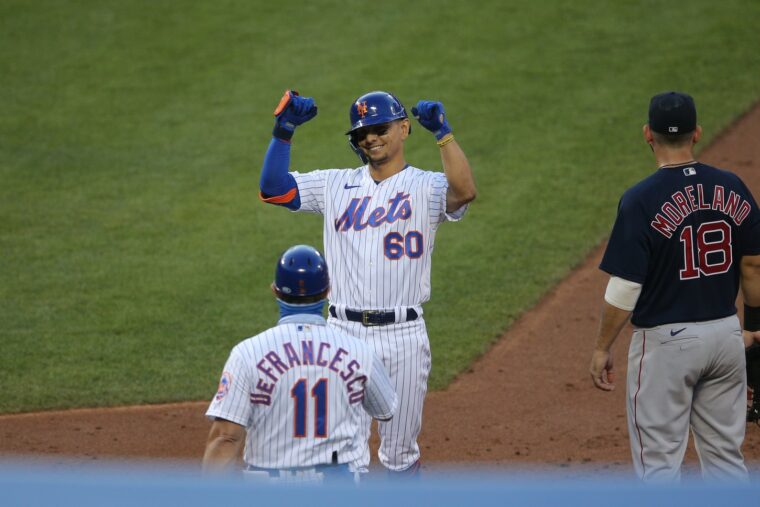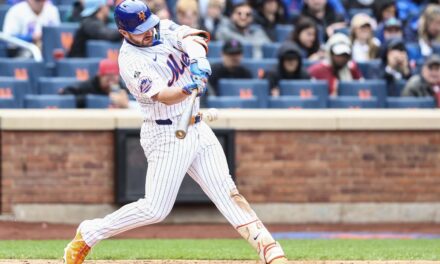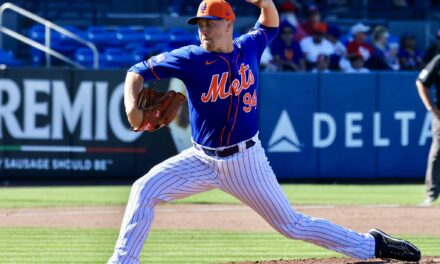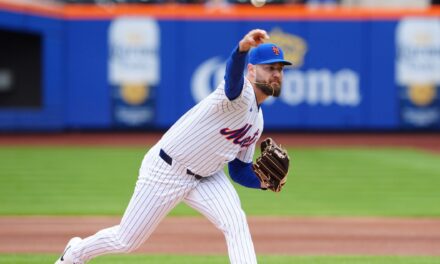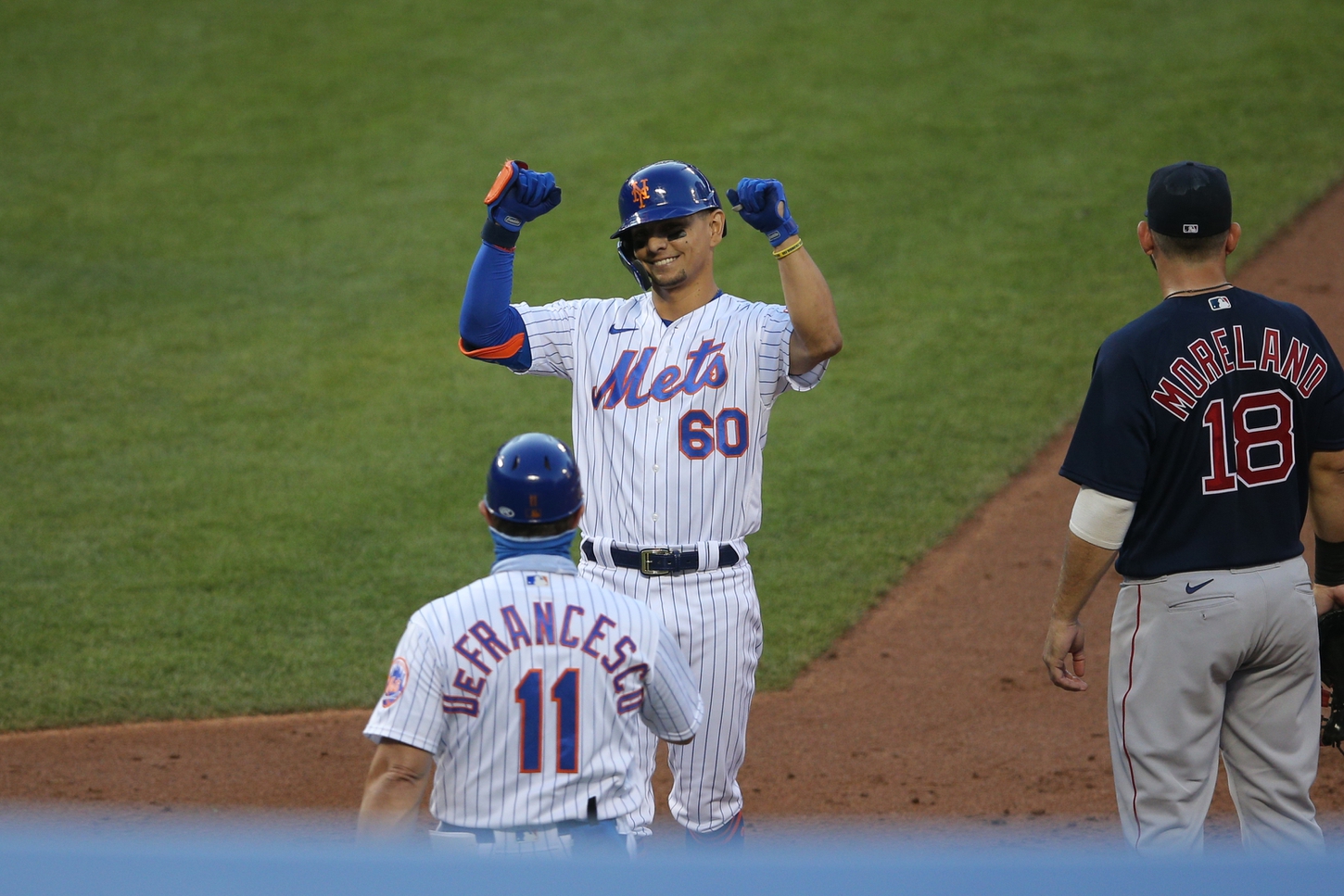
Brad Penner/USA Today
There might not be a person more suited to assess the development of Andrés Giménez than Luis Rojas.
When Giménez first reached Double-A — commonly referred to as the Great Separator, as in separating the legitimate prospects from the rest — Rojas was there to greet him.
And when Giménez cracked a major league starting lineup for the first time on Wednesday, it was Rojas who penciled him in.
The shortstop rewarded his manager with his first hit, a single, and first RBI, a run-scoring triple, in the Mets’ eventual 6-5 loss to the Boston Red Sox.
#SaveThatBall, it’s Andrés Giménez’s first major league hit. pic.twitter.com/RgrqNIGOGl
— Jacob Resnick (@Jacob_Resnick) July 29, 2020
“It’s a different approach right now compared to when I managed him in 2018 [with Double-A Binghamton],” Rojas said. “Now it’s more calm, I should call it, and able to create a little more leverage. Balls [are] jumping out of his bat more, which is naturally what happens in development.”
That development, which began as a highly-touted international signing just five years ago, took an interesting turn when Giménez surprisingly landed on the Opening Day roster, mostly out of necessity.
Had things stayed on course during spring training in March, he would have headed to Triple-A Syracuse and may not have seen the majors without an injury above him on the depth chart.
With the active roster size increased to 30 for the first two weeks of the shortened season the Mets felt that Giménez, who was already on the 40-man roster, could best continue his development in the majors while also giving the team a boost with his glove and speed.
“I feel good in the clubhouse and on the field,” he said. “I just feel blessed to be here and helping the team to win.”
Used frequently as a defensive replacement in the season’s first week, Giménez might have something to offer with the bat, too. His triple left the bat at 102 mph and sailed over the head of Jackie Bradley Jr., one of the game’s premier central defenders.
102 mph off the bat to dead center for Andrés Giménez’s first MLB RBI. #Mets pic.twitter.com/zJvTaFYRGU
— Jacob Resnick (@Jacob_Resnick) July 30, 2020
To those who have seen his full body of work, it’s the realization of more to come.
“That started in that first camp,” Rojas said. “[Now], I’m expecting for him to do something like that — impact the ball a little harder than what I used to see him [do] two years ago.”
Not much has changed over that time in the areas where Giménez has been lauded the most. His glove might never win him gold, but it’s good enough to where he’ll have a job even if he forgets that the bat is supposed to make contact with the baseball.
His speed — well, 93 stolen bases over four seasons do the talking.
But Giménez’s bat is going to determine his ultimate fate as a big leaguer and the one that Rojas first met is mechanically different from the one he’s seeing now.
Here he is in 2017 with the Columbia Fireflies. Pay close attention to the front leg.
Now back to Wednesday.
The organization has always believed that Giménez has a pocket of game power somewhere within him that has yet to be actualized. In what seemed to be an effort to speed up the process, he had his swing retooled to emphasize that leg kick and his hand placement, ultimately trading some of a known tool (his contact skills) for the hope that more pop would follow.
The early returns were not great.
From 2018 (the Rojas year) to 2019 (the swing-change year), Giménez saw a 30-point drop in batting average thanks to a 31-point drop in average on balls in play. His strikeouts went up, his walks went down, and most notably, his power numbers were virtually unaffected.
The positives? At just 20 years old, and despite the aforementioned struggles, he still managed to produce a league-average output (105 wRC+) against opponents mostly four or five years his elder. After the season, he led the Arizona Fall League with a .371 average.
His next nine months, in brief: a 40-man roster add in November, an impressive big league camp in March, and his major league debut at 21 in July. Talk about momentum.
The directions in which Giménez can go from here are too varied. He is going to go through major growing pains, specifically because most teams don’t throw legitimate prospects who have only slowly adjusted to a swing change to the wolves. (The wolves are major league pitchers. You know, the best at their craft in the world.)
It’s a question of how long he stays here, too. When rosters decrease from 30 to 28 on August 6, Giménez could find himself caught in a numbers game as it becomes more difficult to carry someone primarily being used for defense.
But depending on how quickly his bat can develop, and given his ability to play second and third base along with shortstop, there’s an opening for him to seize a spot.
“This season has been a tough mountain to climb,” Giménez said. “But I’m here and I have the opportunity so I just thank God for that and try to help the team win.”


